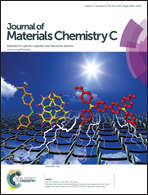Dual mode emission of core–shell rare earth nanoparticles for fluorescence encoding†
Abstract
The demands for multiplexed biological detection have driven the development of fluorescence encoding nanoprobes. We have synthesized water-soluble dual mode emission core–shell rare earth nanoprobes (∼30 nm) for fluorescence encoding. The nanoprobes were composed of ytterbium (Yb), erbium (Er) and/or thulium (Tm) ions co-doped heterogeneous NaYF4/NaLuF4 nanocrystals as cores and amorphous SiO2 embedded with europium (Eu) or terbium (Tb) complexes as shells. Excited by both infrared light and ultraviolet light, the nanoprobes exhibited dual characteristic emissions, which enable a novel spectral encoding strategy. The core nanocrystals exhibited tunable up-conversion emissions through various lanthanide ions doping. Combining these multiple upconversion emissions of core nanocrystals with downconversion emissions of shell containing rare earth complexes, a large amount of distinct fluorescence codes can be generated.


 Please wait while we load your content...
Please wait while we load your content...